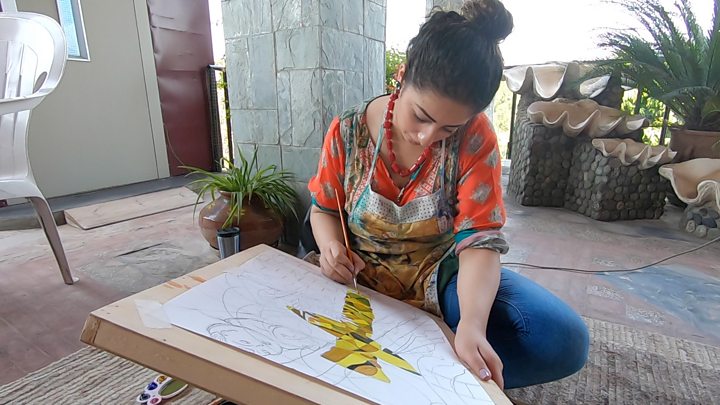Nasim Yousufzai started digging art with a pencil, struck some oil, and ended up in scrap, so to speak.
From unlikely origins, the 50-something metal artist from Pakistan's north-western city of Peshawar has done all of this, and more.
His biggest exhibit was when he designed a huge float for the Pakistan Day parade in 1995, winning second prize.
Then in 2001, he took to the air by designing a makeshift aircraft from an old automobile engine, used car tyres, wooden propellers and wings made of steel pipes covered with canvas sheets.
He flew the machine for five minutes, before he was waved down by his brothers who dragged him home where his panicked mother ordered him never to do it again.
He has since abided by that order.
The son of a day labourer who had migrated from his native Swat region to Peshawar in search of work, Nasim's childhood was steeped in poverty.
But he appears to have made the best of it.
"My elder brother didn't want to study, and my father was happy for him to drop out of school, but I refused to do that, and my father didn't force me," he says.
As a child, he did everything he could to help his family while he studied. After school he would go to a nearby wholesale market to buy vegetables, which he sold in his neighbourhood. Then he worked part time as a helper at an electric store, and also at a tailor's shop where he learned stitching.
"Since my earliest years, I somehow developed a passion for drawing," he says.
That might have sparked his talent for designing things in later life - and in recent years making art out of scrap metal.
"I couldn't resist grabbing a paper and a pen to draw anything that caught my interest, which gradually expanded from household objects to living things."
He completed a diploma in electrical engineering in 1986 and was immediately offered a job, which he still holds.
Alongside his work, he started producing political cartoons for a couple of local newspapers which not only added to his income, but also satisfied his creative urge.
When he joined evening classes at Nishtar Hall, Peshawar's main cultural centre for music and art, he learned to paint, producing a number of oil paintings on large canvasses.
In late 1994, he spotted a newspaper advertisement inviting artists to produce a float representing the culture and history of Khyber Pakhtunkhwa province (then called North-West Frontier Province, or NWFP), for use at the annual Pakistan Day parade in Islamabad.
He applied and his idea was approved for official funding.
Over the next two months, he camped in Islamabad, building a massive float using wood, thermopore sheets, plaster of paris and hundreds of jute bags.
The scene that he crafted showed a male Pathan, KP's dominant ethnic group, a British-era hilltop fort, the building of one of Peshawar's oldest graduate colleges, and Tarbela Dam, the largest in Pakistan.
The float was loaded onto a 22-wheel trailer and driven past the stage where the president and the prime minister were seated.
Having seen Naseem assembling the aircraft in the courtyard of their house, his brothers vaguely knew what he was building. But his mother, who had lived in a village all her life, didn't have the slightest idea.
She came to know when someone rang her up and told her. At that time Naseem had arrived at an air strip in a small town just north of Peshawar, and was readying his plane for the flight.
There had been talk at the time of several home-built aircraft in the region, and one of them near Peshawar had crashed, killing the pilot. So his mother was greatly alarmed.
"I must have been five minutes in the air when I saw my brothers arriving on the scene and frantically waving at me to come down," he recalls.
He acquiesced.
It wasn't until some time in 2014 that metal art caught Nasim's attention.
The trigger was an increased accumulation of metal scrap in his surroundings, both at home and at work - Naseem was a practicing electrician and his brothers had gone into the auto parts business.
"One day I just thought I should do something different," he says. "There were lots of old and rusted steel rivets at home which I put together to shape a dog."
He also toyed with coins to craft shapes, including the portrait of his once-favourite politician - and now Pakistan's prime minister - Imran Khan.
Since metal art mostly involves shapes of living things, more conservative relatives who visited Naseem and saw his creations would remind him of the old Muslim refrain that making images of living things is un-Islamic.
So he stopped working at home and now creates art at his office, where he has set up a small gallery.
He displays dozens of pieces at his gallery, and says thousands more are under lock and key at his house.
Naseem says he is not much given to commercialising his art, but would like to hold a solo exhibition if he gets the chance in the future.
You may also be interested in:

Media playback is unsupported on your device
"artist" - Google News
July 03, 2020 at 06:24AM
https://ift.tt/31DTx5p
Sky is the limit for Pakistan's metal artist - BBC News
"artist" - Google News
https://ift.tt/2FwLdIu
Bagikan Berita Ini














0 Response to "Sky is the limit for Pakistan's metal artist - BBC News"
Post a Comment